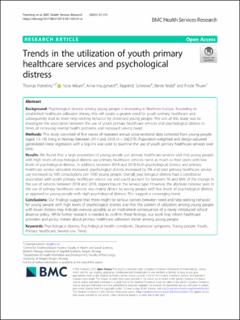| dc.contributor.author | Potrebny, Thomas | |
| dc.contributor.author | Wiium, Nora | |
| dc.contributor.author | Haugstvedt, Anne | |
| dc.contributor.author | Sollesnes, Ragnhild | |
| dc.contributor.author | Wold, Bente | |
| dc.contributor.author | Thuen, Frode | |
| dc.date.accessioned | 2021-07-29T11:47:32Z | |
| dc.date.available | 2021-07-29T11:47:32Z | |
| dc.date.created | 2021-03-11T16:38:12Z | |
| dc.date.issued | 2021-02-03 | |
| dc.identifier.issn | 1472-6963 | |
| dc.identifier.uri | https://hdl.handle.net/11250/2765622 | |
| dc.description.abstract | Background: Psychological distress among young people is increasing in Northern Europe. According to established healthcare utilization theory, this will create a greater need for youth primary healthcare and subsequently lead to more help-seeking behavior by distressed young people. The aim of this study was to investigate the association between the use of youth primary healthcare services and psychological distress in times of increasing mental health problems and increased service need.
Methods: This study consisted of five waves of repeated annual cross-sectional data collected from young people (aged 13–19) living in Norway between 2014 and 2018 (n = 368,579). Population-weighted and design-adjusted generalized linear regression with a log-link was used to examine the use of youth primary healthcare services over time.
Results: We found that a large proportion of young people use primary healthcare services and that young people with high levels of psychological distress use primary healthcare services twice as much as their peers with low levels of psychological distress. In addition, between 2014 and 2018 both psychological distress and primary healthcare service utilization increased: psychological distress increased by 5% and total primary healthcare service use increased by 500 consultations per 1000 young people. Overall, psychological distress had a conditional association with youth primary healthcare service use and could account for between 16 and 66% of the change in the use of services between 2014 and 2018, depending on the service type. However, the absolute increase seen in the use of primary healthcare services was mainly driven by young people with low levels of psychological distress as opposed to young people with high psychological distress. This suggest a converging trend.
Conclusions: Our findings suggest that there might be serious barriers between need and help-seeking behavior for young people with high levels of psychological distress and that the pattern of utilization among young people with lower distress may indicate overuse, possibly as an inadvertent consequence of a newly introduced school absence policy. While further research is needed to confirm these findings, our work may inform healthcare providers and policy makers about primary healthcare utilization trends among young people. | en_US |
| dc.language.iso | eng | en_US |
| dc.publisher | BMC | en_US |
| dc.rights | Navngivelse 4.0 Internasjonal | * |
| dc.rights.uri | http://creativecommons.org/licenses/by/4.0/deed.no | * |
| dc.title | Trends in the utilization of youth primary healthcare services and psychological distress | en_US |
| dc.type | Journal article | en_US |
| dc.type | Peer reviewed | en_US |
| dc.description.version | publishedVersion | en_US |
| dc.rights.holder | Copyright The Author(s) 2021 | en_US |
| cristin.ispublished | true | |
| cristin.fulltext | original | |
| cristin.qualitycode | 2 | |
| dc.identifier.doi | 10.1186/s12913-021-06124-w | |
| dc.identifier.cristin | 1897413 | |
| dc.source.journal | BMC Health Services Research | en_US |
| dc.source.pagenumber | 1-12 | en_US |
| dc.identifier.citation | BMC Health Services Research. 2021, 21, 115 | en_US |
| dc.source.volume | 21 | en_US |
| dc.source.issue | 115 | en_US |

